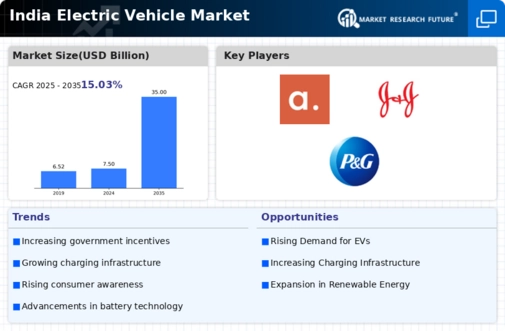The India Electric Vehicle Market is currently characterized by a dynamic competitive landscape, driven by a confluence of technological advancements, regulatory support, and shifting consumer preferences towards sustainable mobility solutions. Major players such as Tata Motors (India), Mahindra Electric Mobility (India), and Ola Electric (India) are at the forefront, each adopting distinct strategies to enhance their market positioning. Tata Motors (India) emphasizes innovation through its extensive research and development initiatives, focusing on electric vehicle (EV) technology and battery efficiency. Meanwhile, Mahindra Electric Mobility (India) is leveraging its established automotive expertise to expand its EV portfolio, particularly in the commercial segment. Ola Electric (India), on the other hand, is aggressively pursuing digital transformation and customer engagement, aiming to create a seamless user experience through its app-based platform. Collectively, these strategies contribute to a competitive environment that is increasingly focused on technological differentiation and customer-centric solutions.
In terms of business tactics, localizing manufacturing and optimizing supply chains have emerged as critical strategies for these companies. The market structure appears moderately fragmented, with several players vying for market share, yet the influence of key players is substantial. This competitive structure fosters innovation and encourages collaboration among companies, as they seek to enhance their operational efficiencies and reduce costs. The collective efforts of these key players are likely to shape the future trajectory of the market, as they navigate challenges such as supply chain disruptions and evolving consumer expectations.
In August 2025, Tata Motors (India) announced a strategic partnership with a leading battery manufacturer to enhance its EV production capabilities. This collaboration is expected to streamline the supply chain and reduce production costs, thereby enabling Tata Motors to offer more competitive pricing for its electric models. The strategic importance of this move lies in its potential to bolster Tata's market share in the rapidly growing EV segment, as it positions the company to meet increasing demand for affordable electric vehicles.
In September 2025, Mahindra Electric Mobility (India) unveiled its new range of electric commercial vehicles, targeting urban logistics and last-mile delivery sectors. This launch is significant as it aligns with the Indian government's push for sustainable transportation solutions, potentially capturing a substantial share of the burgeoning EV market. By focusing on commercial applications, Mahindra Electric is likely to differentiate itself from competitors primarily targeting passenger vehicles, thus carving out a unique niche in the market.
In October 2025, Ola Electric (India) expanded its operations by launching a new manufacturing facility in Tamil Nadu, aimed at increasing production capacity for its electric scooters. This strategic move is indicative of Ola's commitment to scaling its operations and meeting the growing demand for electric two-wheelers. The establishment of this facility not only enhances production efficiency but also signifies Ola's intent to solidify its position as a leader in the electric mobility space.
As of October 2025, current competitive trends in the India Electric Vehicle Market are increasingly defined by digitalization, sustainability, and the integration of artificial intelligence in vehicle design and manufacturing processes. Strategic alliances among key players are shaping the landscape, fostering innovation and enhancing supply chain resilience. Looking ahead, it appears that competitive differentiation will evolve from traditional price-based competition to a focus on technological innovation, enhanced customer experiences, and reliable supply chains. This shift underscores the importance of adaptability and forward-thinking strategies in navigating the complexities of the electric vehicle market.














Leave a Comment